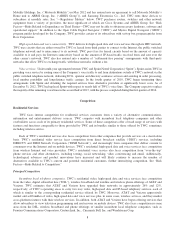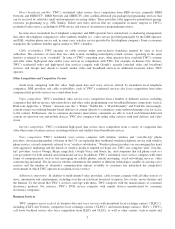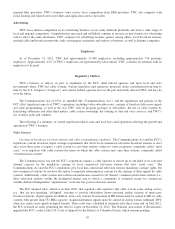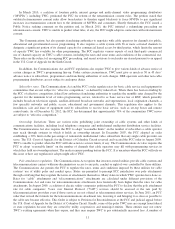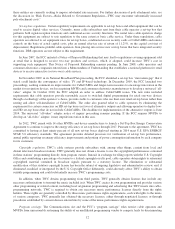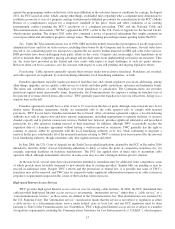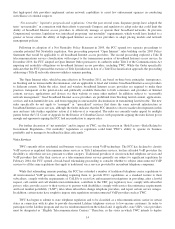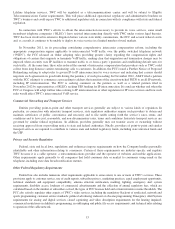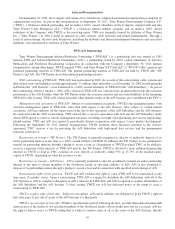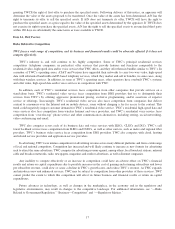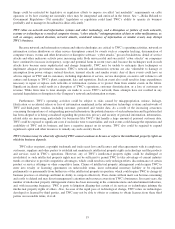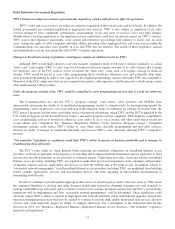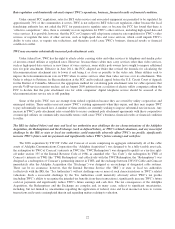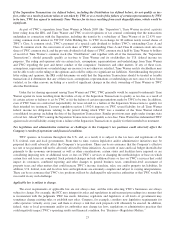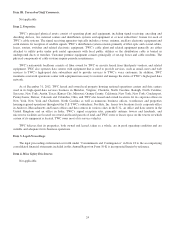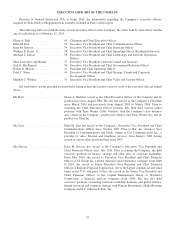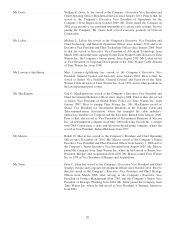Time Warner Cable 2012 Annual Report Download - page 27
Download and view the complete annual report
Please find page 27 of the 2012 Time Warner Cable annual report below. You can navigate through the pages in the report by either clicking on the pages listed below, or by using the keyword search tool below to find specific information within the annual report.granting TWCE the right of first offer to purchase the specified assets. Following delivery of this notice, an appraiser will
determine the value of the assets proposed to be transferred. Once the value of the assets has been determined, A/N has the
right to terminate its offer to sell the specified assets. If A/N does not terminate its offer, TWCE will have the right to
purchase the specified assets at a price equal to the value of the specified assets determined by the appraiser. If TWCE does
not exercise its right to purchase the specified assets, A/N has the right to sell the specified assets to an unrelated third party
within 180 days on substantially the same terms as were available to TWCE.
Item 1A. Risk Factors.
Risks Related to Competition
TWC faces a wide range of competition, and its business and financial results could be adversely affected if it does not
compete effectively.
TWC’s industry is, and will continue to be, highly competitive. Some of TWC’s principal residential services
competitors (telephone companies, in particular) offer services that provide features and functions comparable to the
residential video, high-speed data and/or voice services that TWC offers, and they offer them in bundles similar to TWC’s. In
a number of TWC’s operating areas, AT&T and Verizon have upgraded their networks to carry two-way video, high-speed
data with substantial bandwidth and IP-based telephony services, which they market and sell in bundles, in some cases, along
with their wireless services. In addition, in some of TWC’s operating areas, other operators have overbuilt TWC’s systems
and offer video, high-speed data and/or voice services in competition with TWC.
In addition, each of TWC’s residential services faces competition from other companies that provide services on a
stand-alone basis. TWC’s residential video service faces competition from DBS providers that try to distinguish their
services from TWC’s by offering aggressive promotional pricing, exclusive programming, and/or assertions of superior
service or offerings. Increasingly, TWC’s residential video service also faces competition from companies that deliver
content to consumers over the Internet and on mobile devices, some without charging a fee for access to the content. This
trend could negatively impact customer demand for TWC’s residential video service. TWC’s residential high-speed data and
voice services also face competition from wireless Internet and voice providers, and TWC’s residential voice service faces
competition from “over-the-top” phone service and other communication alternatives, including texting, social networking,
video conferencing and email.
TWC also competes across each of its business data and voice services with ILECs, CLECs and IXCs. TWC’s cell
tower backhaul service faces competition from ILECs and CLECs, as well as other carriers, such as metro and regional fiber
providers. TWC’s business video service faces competition from DBS providers. TWC also competes with cloud, hosting
and related service providers and application-service providers.
In advertising, TWC faces intense competition for advertising revenue across many different platforms and from a wide range
of local and national competitors. Competition has increased and will likely continue to increase as new formats for advertising
seek to attract the same advertisers. TWC competes for advertising revenue against, among others, local broadcast stations, national
cable and broadcast networks, radio, newspapers, magazines and outdoor advertisers, as well as Internet companies.
Any inability to compete effectively or an increase in competition could have an adverse effect on TWC’s financial
results and return on capital expenditures due to possible increases in the cost of gaining and retaining subscribers and lower
per subscriber revenue, could slow or cause a decline in TWC’s growth rates, and reduce TWC’s revenue. As TWC expands
and introduces new and enhanced services, TWC may be subject to competition from other providers of those services. TWC
cannot predict the extent to which this competition will affect its future business and financial results or return on capital
expenditures.
Future advances in technology, as well as changes in the marketplace, in the economy and in the regulatory and
legislative environments, may result in changes to the competitive landscape. For additional information, see “—Risks
Related to Government Regulation,” “Business—Competition” and “—Regulatory Matters.”
17



